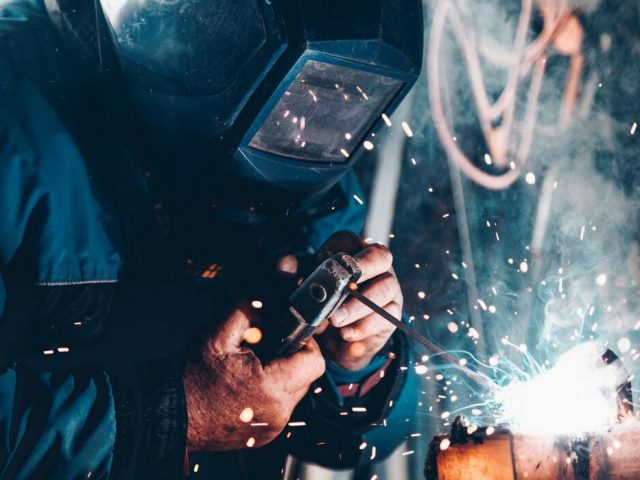There are many pros and cons between robotic welding vs manual welding processes in metal fabrication. There are differences, with each having a number of benefits and drawbacks that fabricators must weigh before deciding which process works best for their shop or job.
Operationally, one is an automated process and the other is done by hand. The former, robotic welding, is a more complex system than the latter. Automated welding is generally better suited for larger manufacturing environments rather than small fabrication shops, and is ideal for large-scale or mass production of parts and components such as in automotive assembly. Whereas manual welding is ideal for custom jobs that may call for a high degree of skill but not produced in mass.
Not all robotic welding processes are fully automated, either. Some robotic processes are semi-automatic that requires operator assistance in manually loading the metal and removing it once the weld is completed. On the other hand, fully automated robotic systems guide the metal through the entire welding process, from beginning to end. In manual welding, every step from start to finish is done by hand.
In weighing the options, every welding technique has its own set of pros and cons. Let’s take a closer look:
The Pros of Robotic Welding
Quality
Robotic weld process controllers maintain weld integrity and the automated processes offer high repeatability. This ensures accuracy and a consistent weld each time.
Increased Output and Safety
Robots not only perform accurate, consistent welds with high repeatability, but they do so at an accelerated pace much faster than humans. Distractions or fatigue factors which are often the cause of injury are also eliminated.
Less Material Waste
Because robot-controlled welding is programmable and performed with a high level of accuracy and efficiency, only the material required is used, greatly reducing scrap associated with manual welding.
Reduced Labor Costs
Whether implementing a fully automated or semi-automatic system, robotic welding operations require fewer workers, which will reduce the cost of labor and any associated labor costs such as injury, sick leave, or staff turnover.
The Cons of Robotic Welding
Investment
That money saved on reduced labor costs will be immediately consumed by the considerable investment required to implement a robotic welding system. However, in time, even with routine maintenance and upgrades, most companies do realize an ROI.
Decreased Flexibility
The prime attraction of robotic welding systems is high quality and increased production. That production, however, is limited to doing the same tasks over and over again. As with any fixed automated manufacturing process, system downtime to reconfigure the welding robots every time a different task is required may be costly.
Dependency
If the operation is entirely dependent on a welding robot or robots, if one or more of the welding robots go down, production could be halted for a considerable time.
The Pros of Manual Welding
Quality and Detail
Manual welding offers superb quality and handcrafted, detailed finishes to products that robotics cannot equal.
Increased Flexibility
The ability of certified welders onsite to perform a variety of welding jobs provides fabricators a degree of flexibility in what they can offer their customers. More types of welding projects can be accommodated, too, with much less lead time than robot welders.
Interchangeability of Tasks
When one welder calls in sick, that job or task can be reassigned to another welder without production being halted for an extended time.
Cognitive Awareness
Because of the mental processes involved in manual welding, if a problem arises during fabrication or on the manufacturing floor, a human welder will stop and address the problem immediately. In contrast, until the controller recognizes the problem, a robotic welder will continue to repeat the task as programmed until it malfunctions.
The Cons of Manual Welding
Limitations
In truth, there are no cons related to manual welding, only limitations. Manual welding processes take greater time and such tasks cannot be performed at the speed and efficiency in which a robot can perform the task.
Repeatability
Manual welding cannot mass produce a part or component the exact same way every single time.
Injury
Welding is not without an element of risk. People can and do get injured on the job. If a robot breaks down it may slow production, but it cannot be hurt.
Welding is a precision fabrication technique that can be performed manually or by robotics, and today there are many full-service fabrication shops that may offer both to better serve customer needs. Without a doubt, there are pros and cons to each method. If there is one constant between the two welding processes, it is that nearly all industries rely on some form of welding to fabricate materials used in production and that one of the two methods will surely be used to do so.
To learn more about robotic welding vs manual welding or to inquire about our metal fabrication services, please contact us at Quest-Tech today.



